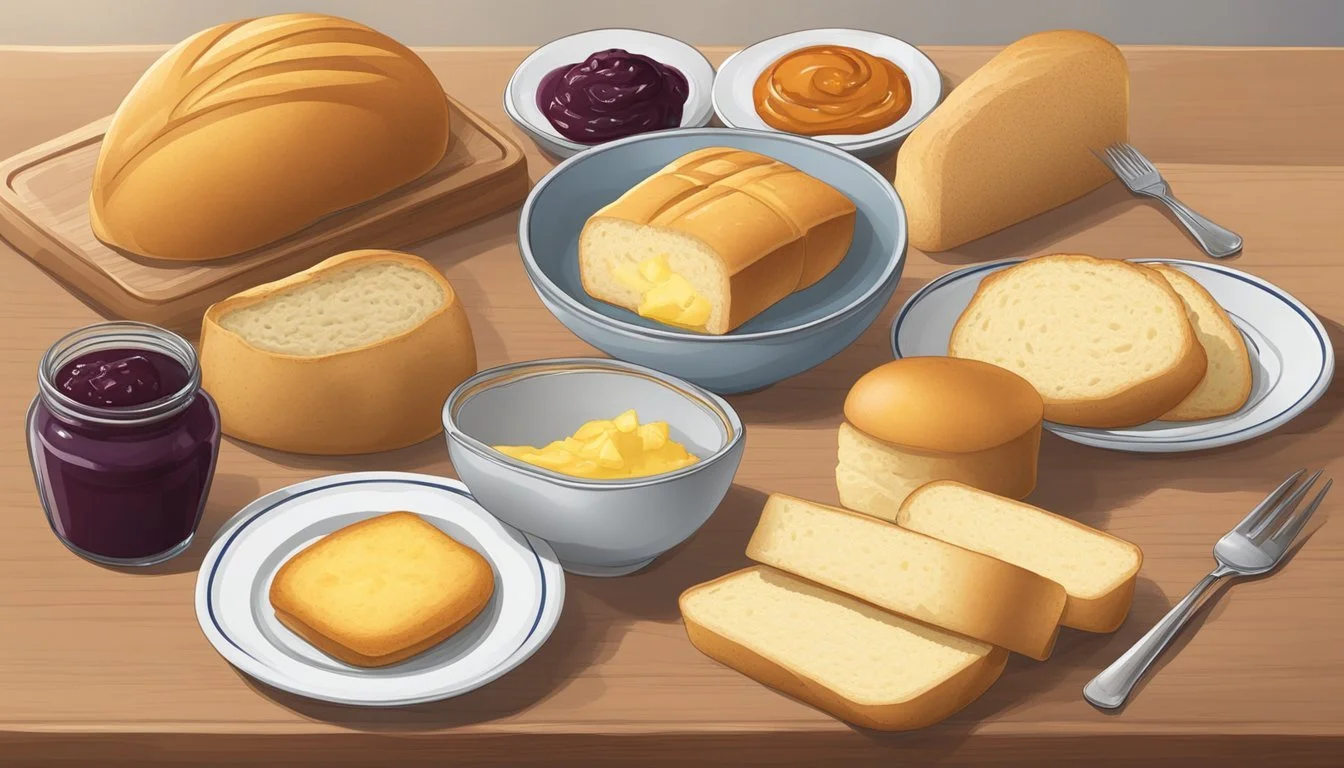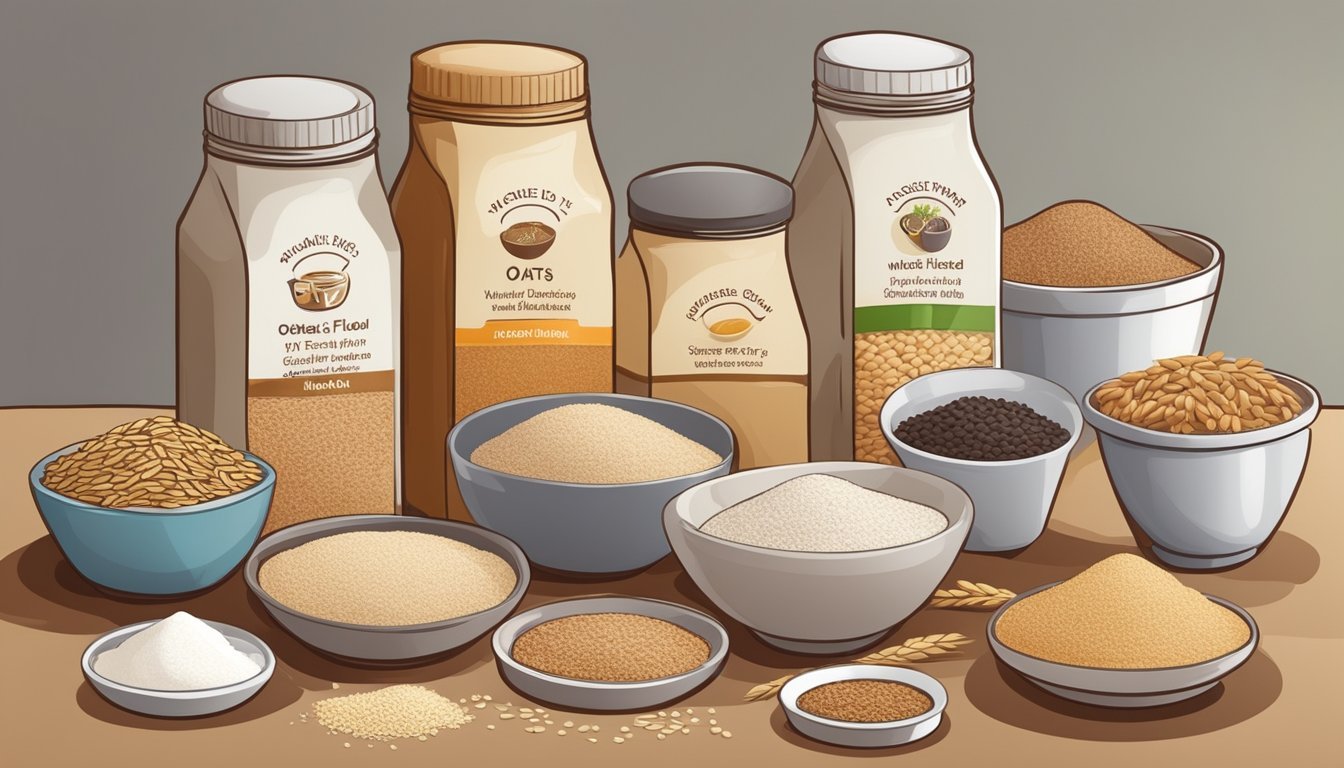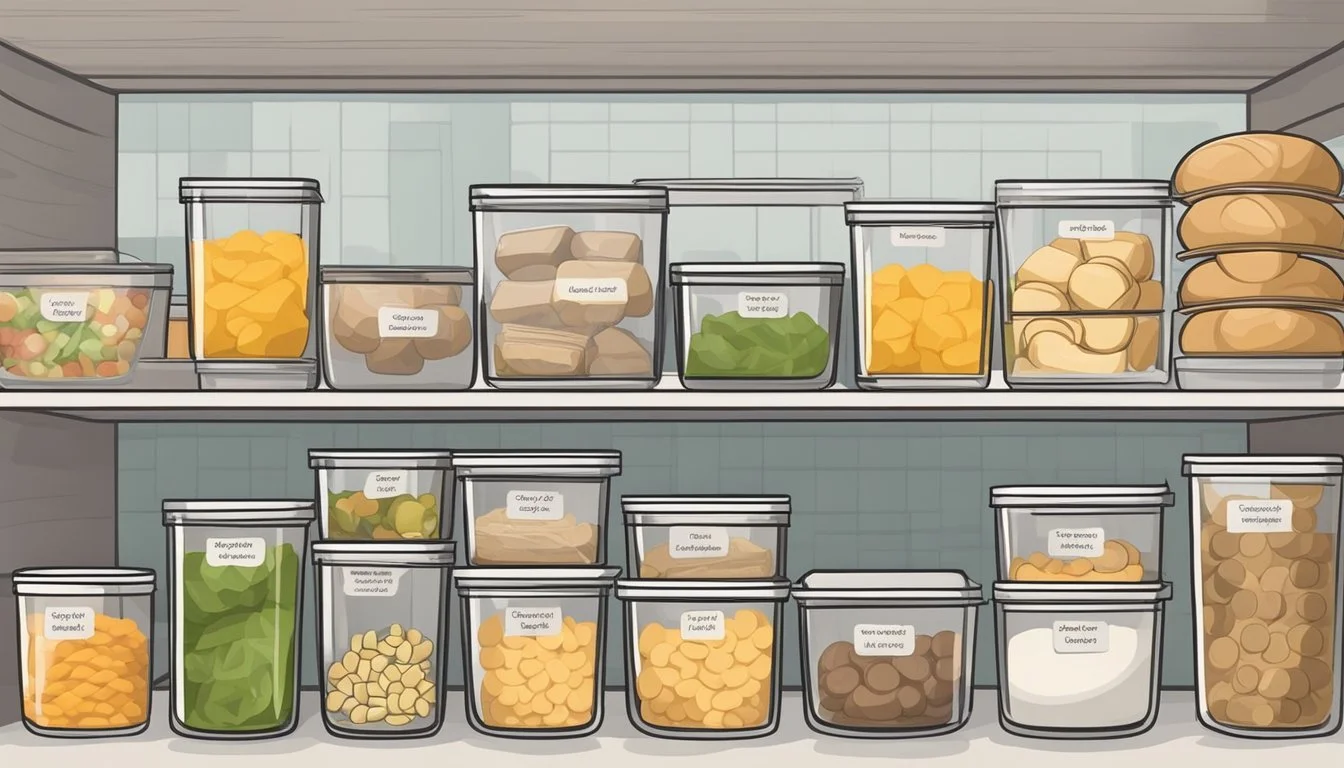Dinner Roll Substitutes
Healthy and Delicious Alternatives for Your Meal
Dinner (What wine goes well with dinner?) rolls are a staple at many dining tables, often served as a prelude to a main course or as an accompaniment to a hearty meal. Their soft, fluffy texture and rich, buttery taste make them a favorite for sopping up sauces and gravies. However, with dietary restrictions and preferences guiding many people's eating habits, the need for alternatives to traditional dinner rolls has become increasingly important.
Substitutes for dinner rolls come in various forms, each offering different nutritional profiles and flavors to cater to diverse diets. Whether for gluten intolerance, carb-reduction, or for incorporating more whole grains, finding a suitable substitute means considering the primary function the roll serves in a meal—be it as a vessel for other foods, a palate cleanser, or simply as a cherished tradition.
In the quest to replace dinner rolls, options range from lettuce wraps and cauliflower buns to more innovative creations like eggplant slices or mushroom caps. For those mindful of nutrition, whole-grain alternatives or rolls made from alternative flours offer a way to maintain dietary balance without sacrificing the enjoyment of a shared mealtime experience. Each of these substitutes provides a way to enjoy the essence of dinner rolls while accommodating various dietary needs.
Benefits of Homemade Dinner Rolls
When one opts for homemade dinner rolls, they gain control over nutritional content and can tailor the recipe to meet dietary preferences or restrictions. This approach ensures rolls are fresh, fluffy, and packed with desired flavors.
Nutritional Advantages
Homemade dinner rolls often boast higher nutritional value compared to store-bought alternatives. One has the liberty to select quality, unprocessed ingredients, which can result in rolls that are:
Higher in protein: By incorporating whole grain flours or adding seeds such as flax or chia, the protein content can be enhanced.
Rich in complex carbohydrates: Choosing whole wheat flour over refined increases the presence of complex carbohydrates, providing a steadier release of energy.
Customizable Ingredients
The advantage of customizable ingredients in homemade dinner rolls cannot be overstated. It empowers the baker to:
Modify fat content: The baker can use oils rich in unsaturated fats or simply reduce the fat quantity in the recipe.
Enhance flavor and texture: Ingredients like butter can be measured and used to make the rolls exceptionally fluffy and tastefully rich.
Accommodate dietary needs: Gluten-free, low-sugar, and dairy-free options are easily executed when baking from scratch, allowing the rolls to meet specific dietary requirements.
Choosing the Right Ingredients
The ingredients in dinner rolls are critical to their texture, flavor, and rise. Selecting the appropriate variety and quality of each component ensures a superior final product.
Flour Selection
The foundation of any dinner roll is flour. The two main types are all-purpose flour and bread flour. All-purpose flour is versatile and widely used, but bread flour's higher protein content leads to a chewier texture due to more gluten formation during kneading.
All-Purpose Flour: Ideal for soft and tender dinner rolls.
Bread Flour: Best for rolls that require a chewier texture and more structure.
Yeast Varieties
Yeast is a leavening agent that helps the dough rise.
Active Dry Yeast: Must be dissolved in warm liquid before being added to other ingredients. It creates a notable rise.
Instant Yeast: Can be mixed directly with the dry ingredients and tends to work faster.
Temperature is crucial; liquids should be around 95-100°F to activate yeast without killing it.
Fats and Oils
Fats add flavor and tenderness to dinner rolls, affecting their crumb structure.
Unsalted Butter: Provides a rich flavor and controls the salt content.
Olive Oil: A dairy-free option that adds moisture without the heaviness of butter.
Whether using unsalted butter or oil, it should be incorporated in the proper state: room temperature or melted according to recipe instructions.
Liquids for Dough
Liquids activate yeast and hydrate the flour.
Milk: Whole milk enriches the dough, giving rolls a soft texture and richer taste.
Water: A simple choice that hydrates the dough without adding extra flavor or fat.
The temperature of the liquid is critical to properly activate yeast without harming its leavening properties.
Dinner Roll Preparation Techniques
Mastering dinner roll preparation is critical for achieving the perfect texture and flavor. The process involves meticulous kneading, controlled proofing and rising, and precise shaping.
Kneading the Dough
To develop the gluten needed for a soft and elastic texture, one initially kneads the dough thoroughly. Kneading by hand allows for a personal touch, typically involving pressing the dough with the heels of the hands, folding it over, and turning it. Alternatively, a stand mixer with a dough hook attachment can perform this task with consistency and ease, usually taking about 7-10 minutes on a medium speed until the dough is smooth and pulls away from the sides of the bowl.
Proofing and Rising
The rise time, critical in developing the flavor and structure of the rolls, depends on the yeast used. Active dry yeast should first be dissolved in warm water to activate, while instant yeast can be mixed directly with dry ingredients. The first proof, or let rise, usually takes place in a warm, draft-free environment until the dough has doubled in size, which can range from 1 to 2 hours. The dough is then punched down to release excess gas bubbles formed during the fermentation process.
Shaping the Rolls
The final look and presentation of the dinner rolls are determined at the shaping stage. Once the dough has properly risen, it’s punched down then divided into even pieces. Each piece is then shaped by tucking the edges under to create a smooth surface. They are arranged on a baking sheet with adequate space to allow for additional rising. A second proofing ensures that the rolls develop their final size and helps create a lighter texture. This rise is typically shorter, around 30 minutes, and is crucial for the perfect roll.
Baking and Finishing Touches
When baking dinner rolls, precision with oven temperatures and applying an egg wash or toppings are crucial for achieving the perfect golden crust and delicious taste.
Oven Temperatures and Times
The correct oven temperature and baking time are essential to ensure dinner rolls are evenly baked. Most recipes recommend preheating the oven to between 350°F (175°C) and 375°F (190°C). Dinner rolls typically bake for 20-25 minutes, though one should start checking at 15 minutes for smaller rolls. One key to a successful bake is the use of parchment paper on the baking pan, providing a non-stick surface and even heat distribution.
Applying Egg Wash and Toppings
To achieve an irresistible golden sheen on dinner rolls, brushing them with an egg wash—a mixture of egg and water or milk—is effective. To apply, gently brush the tops of the rolls with the wash before baking. For added flavor and texture, sprinkle toppings like sesame seeds after the egg wash. This extra step elevates the rolls from amazing to exceptional.
Alternative Dinner Roll Recipes
When it comes to diversifying your bread basket, alternative dinner roll recipes offer delicious variations to traditional soft dinner rolls. They can cater to dietary restrictions and flavor preferences, enhancing the dining experience for all occasions.
Gluten-Free Options
Gluten-free alternatives allow those with gluten sensitivities to enjoy bread with their meal. One can find recipes for gluten-free dinner rolls that mimic the texture and flavor of traditional rolls. Rice flour, tapioca flour, and xanthan gum are often key ingredients that provide structure without the presence of gluten.
Example Recipe:
Ingredients:
Rice flour, tapioca flour
Xanthan gum
Yeast
Warm water
Sugar
Salt
Vegan butter
Method:
Proof the yeast with sugar and warm water.
Mix dry ingredients.
Incorporate vegan butter and the yeast mixture.
Shape into rolls and let them rise.
Bake at 350°F until golden brown.
Vegan Varieties
Vegan dinner rolls exclude all animal products, relying on substitutes like vegan butter and plant-based milks. A popular vegan roll recipe may involve brushing the tops with melted vegan butter post-baking for added richness. An emphasis on dairy-free milk, such as almond or soy, and egg replacer ensures the rolls remain vegan-friendly while still being light and fluffy.
Example Vegan Roll Types:
Classic Vegan Rolls: Soft and similar to traditional dinner rolls.
Garlic Rolls: Infused with garlic and herbs for a savory kick.
Knots: Shaped into knots for aesthetic and texture variation.
Sweet and Savory Flavors
Moving beyond the basic recipe, dinner rolls can be adapted to include a variety of flavors that suit different palates and occasions. Recipes might integrate sweet components like honey or sugar, creating rolls that pair well with jams or as part of a dessert spread.
For savory inclinations, ingredients such as herbs, cheese, and garlic transform a simple roll into something like an artisan bread or focaccia. Cloverleaf rolls, with their distinct shape, are perfect for incorporating herbs and garlic, offering both visual interest and bursts of flavor.
Example Flavorful Rolls:
Sweet Rolls: Add honey or brush with sweet glaze.
Savory Focaccia: Integrate rosemary and sea salt.
Cheese Garlic Rolls: Combine garlic butter and grated cheese.
Troubleshooting Common Issues
When baking dinner rolls, one may encounter various issues that can affect the final product. Understanding how to tackle dough consistency problems and rise and proofing challenges is crucial for achieving the perfect dinner roll.
Dough Consistency Problems
The consistency of the dough is determined by the right balance of ingredients and can be either too sticky or too dry. If the dough feels too sticky, bakers should add flour, a tablespoon at a time, until the dough reaches the desired consistency - it should be tacky, but not stick to the hands excessively. Conversely, a dry dough needs moisture. One can incorporate a small amount of water or milk into the dough until the desired softness is achieved.
Visual cues to dough consistency are important: a properly mixed dough should be smooth and pull away from the sides of the bowl without leaving a lot of residue.
Rise and Proofing Challenges
Problems with rising and proofing can stem from the yeast or the environment where the dough is left to rise. If the dough is not rising:
Check that the yeast is active. Yeast should foam when combined with lukewarm water and a bit of sugar; if it doesn’t, it may be expired.
Ensure the environment is conducive to rising. The dough should be covered and placed in a warm place, between 75°F and 85°F, away from drafts.
A visual indicator of sufficient proofing is the dough doubling in size. The feel of the dough should be slightly puffy and yield slightly to a gentle touch. If proofing takes longer than expected, patience is key; dough can be slow to rise in cooler temperatures.
Storage and Make-Ahead Tips
Proper storage and advance preparation can ensure that dinner rolls remain fresh-tasting and tender. A baker can leverage refrigeration and freezing for extending shelf life, while specific reheating methods can bring rolls back to a just-baked quality.
Refrigeration and Freezing
One can make dinner rolls ahead of time and store them effectively by refrigerating or freezing. For refrigeration:
Shape the rolls and place them on a baking sheet.
Cover tightly with plastic wrap.
Refrigerate for up to 2 days; they will slowly rise.
For freezing:
Fully bake and then cool the rolls.
Wrap each roll in aluminum foil.
Place them in a freezer bag and freeze for up to 1 month.
To use frozen rolls:
Thaw at room temperature, still wrapped, to avoid condensation.
Rolls can be frozen before baking too; proof and bake directly from the freezer, adding extra baking time.
Reheating for Freshness
Revitalizing dinner rolls is easy with proper reheating, which can restore their warmth and texture. To reheat refrigerated rolls:
Preheat the oven to 350°F (175°C).
Place the rolls on a baking sheet.
Heat for 7-10 minutes or until warmed through.
When reheating thawed or room temperature rolls:
Wrap in foil to prevent them from drying out.
Warm in the oven at the same temperature as refrigerated rolls.
Microwave reheating is also possible:
Wrap rolls in a damp paper towel.
Microwave on high for 15-20 seconds per roll.
This method can be useful when in need of a quick way to restore the rolls' warmth and soft texture. However, oven reheating is preferred for a more even heat distribution.
Tools and Equipment for Baking Rolls
Proper tools and equipment are crucial for achieving the perfect texture and flavor in homemade dinner rolls. This section outlines the essentials needed to mix, measure, and bake rolls with precision.
Essential Utensils
Stand Mixer: A staple in any baker's kitchen, a stand mixer with a dough hook attachment is ideal for kneading roll dough efficiently. For those without a stand mixer, a sturdy wooden spoon can be used to combine ingredients before kneading by hand on a work surface.
Bench Scraper: This tool is useful for dividing dough into pieces.
Instant-Read Thermometer: Ensures liquids are heated to the optimal temperature for yeast activation, typically between 95-100°F.
Measuring Techniques
Ingredient Tool Purpose Flour, sugar, etc. Kitchen Scale For accuracy, ingredients should be weighed. Milk, water, etc. Measuring Cups and Spoons Use for liquids when not using a scale. Eggs Visual Inspection Ensure correct size and freshness.
Accurate measurements are key. For dry ingredients, a kitchen scale is preferable for precision. They must trust their scale to weigh ingredients because even slight deviations can affect the quality of the rolls. For liquids, clear measuring cups allow for precise measurements, while an instant-read thermometer can check the temperature of liquids to ensure they are warm enough to activate the yeast but not so hot as to kill it.
Final Thoughts on Dinner Roll Substitutes
When seeking the best dinner rolls for a meal, it's clear that the basis for excellence lies in texture, taste, and aroma. They often round off a meal but can be a challenge for those with dietary restrictions. Fortunately, there are many substitutes available that maintain the irresistible allure of a traditional dinner roll.
For those avoiding dairy, dairy-free dinner rolls are achievable by using plant-based butters and milks. The richness and shine typically imparted by butter aren't lost; vegan alternatives provide a similar decadence and visual appeal.
In the realm of egg-free options, vinegar and baking soda offer a science-backed solution. They create the desired lightness in rolls, making the end product airy without the use of eggs. This simple substitute ensures the rolls remain easy to make, keeping the process accessible for home bakers.
Those in search of a more complex flavor profile can incorporate various spices and herbs like rosemary, which can transform the sensory experience. Here's a small table highlighting potential substitutes:
Ingredients Substitutes Dairy (butter) Plant-based butters Eggs Vinegar and baking soda mixture Flavor Enhancers Fresh or dried herbs and spices
One should not overlook the importance of correct preparation techniques either, such as scoring the rolls or employing an egg wash for those not restricted by egg allergies. Each of these steps contributes to the final product.
In conclusion, no matter the dietary requirements or flavor preferences, one can create dinner rolls that are not only a joy to make but a delight to consume. The array of substitutes ensures that everyone can enjoy this staple side item without compromise.






